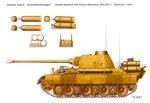- Thread starter
- #81
CharlesBronson
Senior Master Sergeant
Honestly I dont have a clue why they did that, I suppose they had a spare Panther chassis and a spare Pz IV turret so they think...why not? and married it.
And yes the Pz IV ausf G turret used a K.w.K 40 75 mmm gun with 48 calibres in lenght.

And yes the Pz IV ausf G turret used a K.w.K 40 75 mmm gun with 48 calibres in lenght.










